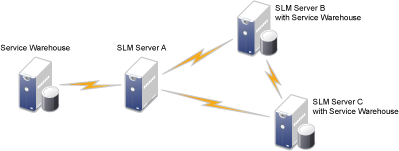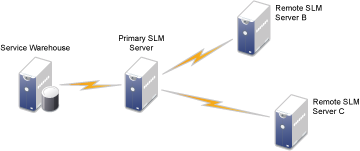5.3 Resource Distribution
After you have determined what data you will collect and who will use the data, you should consider how to distribute the data among different resources. In particular, you should consider how to distribute the data collected for alarm historical and historical performance and service level agreements. This data is stored in the Service Warehouse. In addition, a license to the Operations Center Service Level Manager (SLM) is needed to manage and administer data related to service level agreements (SLAs).
For more information on SLM and SLAs, see the Operations Center 5.6 Service Level Agreement Guide.
Access to the Service Warehouse and alarms history data can be achieved in a distributed or centralized environment. InterConnection adapters are required to connect multiple Operations Center servers.
For more information on how to configure InterConnection adapters, see the Operations Center 5.6 Adapter and Integration Guide.
5.3.1 Distributed Environment
In a distributed architecture, the workload to monitor and store alarms history can be distributed to multiple Operations Center servers. Distributed historical data can be accessed from any Operations Center server with an InterConnection adapter by using service models that contain elements from the InterConnection adapters (from the remote servers).
Figure 5-4 Distributed Historical Data Configuration

In order to monitor and manage historical performance and SLA data for elements on these remote servers, it is necessary to deploy SLM on each remote server that needs to monitor and manage historically.
InterConnection adapters are then configured to connect pairs of SLM servers. Each SLM server stores historical performance and SLA data locally to establish distinct SLAs and store historical performance and SLA data for each SLM server independent of all other SLM and/or servers.
5.3.2 Centralized Environment
For centralized SLA monitoring and management, you should establish SLAs on a primary server while leveraging the InterConnection adapter connections to centrally establish SLAs on remotely monitored data.
Figure 5-5 SLA Configuration

Access to historical performance and SLA data from remote SLM servers requires users to connect directly to the SLM server where data is stored, or connect to that server via its portal.